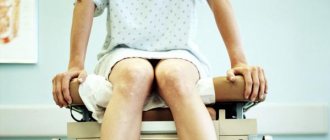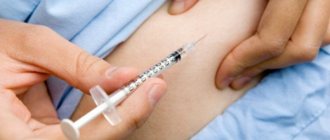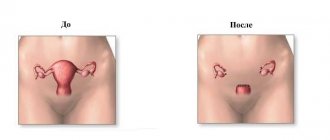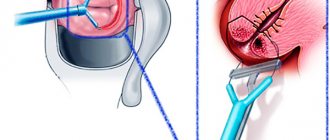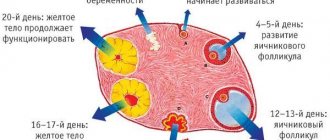Author of the material At the Center for Endovascular Surgery, Prof. Kapranov undergoes operations to remove uterine fibroids. Interventions are carried out by experienced specialists. Professionals always take into account the patient’s health status and strive to ensure that after the operation she can recover as quickly as possible, return to her normal life, and, if desired, carry and give birth to a healthy child.
Are you planning to agree to an operation that is performed surgically rather than endovascularly? Carefully weigh all its pros and cons. Be sure to consult with several specialists. Please also familiarize yourself with the information we provide to you.
How long does disability last for gynecological interventions?
The average length of sick leave after surgery is 10 days. The reduction of this period or its extension depends on the severity of the operation and the presence of associated complications. According to severity they are distinguished:
- Lungs - the patient is fully able to work and can start work the next day. BL is not issued. In some cases, a period of up to 3 days is provided.
- Moderate – it takes time to recover, some bodily functions are impaired. Duration of BL is up to 30-45 days.
- Severe – after the main stage of treatment, a long rehabilitation period is required. BL for more than 45 days.
Gynecological operations are classified as light and moderate surgical interventions . Conditions after removal of oncology are considered severe if, according to histology (examination of removed tissue), a malignant tumor is confirmed. In this case, the doctor refers the patient to medical examination, where a disability group is assigned.
Contraindications
In emergency situations, surgical intervention is unacceptable only in case of acute respiratory disease (influenza, acute respiratory viral infection) with high fever and impaired respiratory function. Elective abdominal surgery is contraindicated:
- for any acute or exacerbation of a chronic infectious process;
- if there are boils or pustules on the skin of the abdomen;
- if any type of rash is detected on the skin;
- against the background of serious pathology of the heart and blood vessels (uncontrolled arterial hypertension, heart attack, stroke, aneurysm, heart defects);
- against the background of liver and kidney diseases with worsening chronic pathology of these organs.
Underestimation or neglect of contraindications to surgery can be the main reason for postoperative complications.
How many days of sick leave are given after different operations?
All days on sick leave are subject to payment . The exception is cases when the patient did not show up for an appointment on time or violated the regime, then the certificate of incapacity for work is closed in violation and the possibility of payment remains at the discretion of the employer.
Hysteroscopy
It is a minimally invasive surgical procedure and is often performed on an outpatient basis. If it is performed for diagnostic purposes and does not have complications, then the issuance of sick leave may be refused. For such manipulations, a period of 3 days is provided.
Cauterization of erosion
The procedure is always carried out on an outpatient basis, usually during an appointment with a specialist. After a preliminary consultation and tests, the woman comes for an appointment. The intervention lasts no more than 20–30 minutes. Immediately after graduation, she is able to work and can lead her usual lifestyle. Sick leave is not issued.
Conization of the cervix
It is a minimally invasive operation, but involves partial removal of the cone-shaped section of the cervical canal. Sick leave can last 5-15 days . This depends on the type of pathology for which surgical treatment was indicated and the extent of the intervention, since the removed area may differ in size in different cases.
Indications for abdominal surgery
Abdominal surgery for uterine fibroids and its postoperative period is a very labor-intensive process that requires patience and strength from the patient. Indications for this surgical intervention are:
- any uterine fibroids, regardless of size, leading to severe uterine bleeding or heavy periods, accompanied by severe anemia;
- leiomyoma is a large formation that, as it grows, begins to compress closely located neighboring organs;
- rapid growth of uterine fibroids, which is characterized by doubling in size within one year;
- infertility, the explanation of which is the presence of uterine fibroids and many others.
What affects the duration of sick leave?
In an attempt to get a ballot, some people resort to tricks and invent symptoms that actually do not exist. With the help of ultrasound, MRI, tests and other diagnostic procedures, the doctor can reliably determine the presence of symptoms and make a decision on whether to open sick leave or deny it.
The duration of sick leave is determined:
- the need for hospitalization;
- the presence of complications and the risk of their development;
- complexity of the operation;
- volume of intervention.
Grounds for extending a certificate of incapacity for work
Complications of surgery may include:
- bleeding;
- the addition of a secondary infection, with the subsequent development of inflammation;
- temperature increase;
- severe pain syndrome;
- failure of the postoperative scar (its divergence or suppuration).
How many days should it be extended?
The period for which a doctor can single-handedly issue a certificate of incapacity for work is 15 days. Next, the patient is sent to a medical commission to justify the extension of the certificate of incapacity for work.
If he is in a hospital, then during medical rounds the examination is carried out by expert doctors; if he is undergoing outpatient treatment and was discharged with an open sick leave, then the attending specialist makes an appointment during the working hours of the VC (medical commission), where the examination is also carried out by experts, based on its results a decision is made conclusion on the possibility of extension.
Menu
Sample menu based on women's reviews for the week:
- Monday . For breakfast, you can cook oatmeal and drink green tea with lemon. Eat an apple as a snack. For lunch, eat vegetable soup and rice with stewed fish, drink carrot juice. For an afternoon snack, drink a glass of kefir or eat cottage cheese with fruit. For dinner, make a salad of fresh vegetables and bake a chicken breast. Yogurt is allowed at night.
- Tuesday . Wheat porridge and a glass of citrus juice. As a snack - one cookie (biscuits) and low-fat yogurt. For lunch - cabbage soup, steamed fish cutlets, green tea or hibiscus. Afternoon snack – salad of vegetables or fruits. Dinner – cheesecakes or cottage cheese casserole. Before bed - kefir.
- Wednesday _ Oatmeal with honey and rosehip infusion. Snack – yogurt. Lunch – bean soup, fish cooked in a steamer, vegetable salad. Afternoon snack – nuts, dried fruits, tea. Dinner – vegetable stew and salad with herbs. At night - yogurt.
- Thursday . For breakfast, steamed omelet (1 egg), tea. Snack – any fruit. Lunch – chicken soup, buckwheat porridge and fish, juice. Afternoon snack – cottage cheese casserole, compote. For dinner - lazy cabbage rolls with soy sauce, kefir. At night - tea and a couple of biscuits.
- Friday . For breakfast - rice porridge with raisins and weak coffee with milk. Snack – fruit. Lunch – beetroot soup (you can add low-fat sour cream), vegetable salad and fish cooked in a double boiler. Afternoon snack – yogurt or kefir. Dinner – low-fat cottage cheese with pieces of fruit, compote or tea. At night - fruit jelly.
- Saturday . A fasting day is recommended once a week - you need to eat 4-5 times, but all meals should consist of vegetable and fruit salads, fermented milk products and a small portion of chicken.
- Sunday . Once a week you can allow yourself a little unhealthy, but so beloved food.
Design features
A sick leave certificate is issued on the day of surgery , if it is performed on an outpatient basis, or on the day of hospitalization, if an inpatient stay is required. A gynecologist deals with pathologies of the uterus.
Members of the medical commission can extend sick leave for a maximum of 15 days ; if the incapacity continues, a second extension will be required in the same manner. During this time, the doctor is involved in treatment and diagnosis, fulfilling all the instructions and recommendations given by medical experts of the highest order.
After discharge from the hospital with an open sick leave certificate, a woman must contact the antenatal clinic at her place of residence.
Further treatment and diagnostics will be carried out by specialists on an outpatient basis. In this case, the third-party (issued in the hospital) certificate of incapacity for work is closed through the VK, and the woman is issued a new one, regardless of the duration of the illness.
The code on the sick leave is indicated:
- “01” – for diseases;
- “10” – during manipulations (hysteroscopy).
The procedure for paying sick leave for uterine operations is standard ; all days of incapacity for work are paid. If there is a second place of work and the work experience exceeds 2 years, then the woman can count on receiving a second sick leave to present for payment.
The final decision on the need to issue a sick leave certificate is made by the attending physician. This explains the fact that with the same disease, different women may or may not receive legal grounds not to go to work. All surgical interventions are carried out only after preliminary consultation.
To avoid problems at work, you need to clarify the possibility of obtaining it and the expected duration of treatment. During planned operations, if a woman experiences psycho-emotional discomfort, it is worth postponing going to the doctor on vacation or planning the operation at the end of the week, since the patient’s personal desire is not a reason for opening a sick leave .
Now you know how long they stay on sick leave after hysterectomy and other gynecological operations. All controversial issues are regulated by Order of the Ministry of Health and Social Development of the Russian Federation N 624n “On approval of the Procedure for issuing certificates of incapacity for work.”
If you find an error, please select a piece of text and press Ctrl+Enter.
Didn't find the answer to your question? Find out how to solve exactly your problem - call right now:
+7 (Moscow) It's fast and free!
After the hysterectomy has been performed, the postoperative period can usually take from three months to a year. Such an operation is no longer uncommon today, but still scares many. But, unfortunately, sometimes this is the only correct way to preserve the health and life of a woman.
For what indications is hysterectomy required?
What could be an indication for this operation? There are several main reasons, and all of them are quite serious and can be fatal to a woman. This is primarily ovarian and uterine cancer. Very often, this female organ is surgically excised for fibroids, fibrosis (benign tumor), and less often for endometritis. In rare cases, the uterus is removed after childbirth, for example, if there is severe bleeding caused by injury or infection.
Removal of the uterus: postoperative period
After the operation, the woman will spend two weeks in the hospital. About 5 to 8 days after your hysterectomy, your doctor will remove the staples from the incision. The healing process and its speed depend on the physiology of each patient. After the uterus has been removed, the postoperative period requires therapy aimed at restoring blood, water balance in the body and preventing inflammatory diseases. They also definitely pay attention to the woman’s psychological mood, because any operation is stressful, not to mention gynecological surgery. A sick leave certificate is required for recovery after hysterectomy for up to 45 days.
Rehabilitation after hysterectomy
The attending physician will definitely tell the patient and her relatives what she needs to eat and what foods will contribute to a quick recovery. The diet of a woman who has undergone hysterectomy is strictly outlined during the postoperative period. Strong tea, chocolate, coffee, cottage cheese, and white bread should be excluded from it. In order for the intestines to work again after surgery, a woman needs to eat fractionally, up to 7 times a day. Water consumption should be increased to 4 liters per day. It is also necessary to include in the menu dishes that help weaken the intestines (meat broth, porridge, fermented milk products). The main rule: follow the diet prescribed by your doctor.
Physical activity after surgery
Recovery after hysterectomy should eliminate or minimize stress - you should not lift objects weighing more than 5 kg. You can return to your normal lifestyle only after the stitches have completely healed. By the way, most experienced doctors advise women to get up the very next day after a hysterectomy. Such physical activity will not allow the blood to stagnate, and therefore the healing process will occur faster.
Are there any restrictions?
After the operation, the patient remains in the hospital for another 4-5 days. The operated woman will be able to get up and walk around within a day or two after the intervention, which, by the way, does not last long. Doctors insert a catheter into the vessel, which blocks the uterine artery with special balls. This inhibits blood flow, the fibroid no longer receives nutrients and, accordingly, dies. In this case, the uterus is at rest. That's why you don't have to limit yourself in terms of physical activity, going back to your normal home and work routine immediately after discharge. There are no taboos on exercise and diet (it remains the same).
Ultrasound every year
Ultrasound remains the only recommendation from doctors for those patients who have undergone surgery. You will need to visit an ultrasound diagnostician after 1, 3 months, and then six months and a year after removal of fibroids by embolization. An ultrasound will help determine how much the uterus and nodes have shrunk. Afterwards, the examination should be carried out once a year, and a year and a half after the operation, you can already plan to conceive a child.
What is sick leave and why is it needed?
A sick leave certificate is a document confirming a woman’s incapacity for work. After removal of the uterus, it is issued legally. Filled out on a special form and certified with stamps. This document must contain the following information:
- Last and first name of the patient, as well as her medical card number.
- Description of the disease using coded information. In this case, a certain term is designated by one or another code.
- Signature of the head physician and the patient. The woman must sign in person.
It must be filled out in block letters of the Russian language in black ink. Now it is possible to fill out the form on special printing printers, but there must be spaces between the words. Punctuation is used where necessary. Data must be entered into special columns for this purpose, and going beyond them is prohibited. All written information must comply with the rules of the Russian language and meet legal requirements.
What can't be done?
The following products are not recommended:
- butter and margarine;
- processed cheese and other products containing refractory fats, for example, pastry creams and ice cream;
- fatty meat products, chicken meat is recommended;
- all sweets, with the exception of marmalade, marshmallows and marshmallows (naturally in limited quantities).
- smoked meats and sausages;
- fatty dairy products;
- baked goods - cookies, pies, rolls, etc.
Read about other contraindications for fibroids in this article.
IMPORTANT!
As for the cooking process, it is best to use a double boiler, oven or multicooker. Boiled and stewed foods are also allowed. It is very important to give up fried foods!
The dietary menu for myomatous tumors in the uterus does not have clear instructions; a woman can independently adjust her diet, taking into account the above points.
For how long do they give it?
The postoperative period is the entire time that passes from the operation to the complete recovery of the female body. During this period of time, the early and late stages of recovery occur. For 5-10 days, the woman should be in a hospital under the supervision of a doctor. At this time, the patient may experience very severe pain in the lower abdomen, which is accompanied by loss of appetite and insomnia.
The woman is then discharged from the hospital. At this time, she should be especially attentive to her condition. If new symptoms appear (for example, pain intensifies), an urgent check with a doctor is required. Naturally, during this period there can be no talk of any work. How long does sick leave last after hysterectomy? This usually takes at least 4 weeks, including the period of hospitalization.
But depending on the type of surgical intervention, this interval may vary:
- If vaginal hysterescopy was performed accompanied by a laparoscope, tissue healing occurs faster. Therefore, a woman is given sick leave for no longer than 2-4 weeks.
- For abdominal surgery, which is performed through the abdominal cavity, sick leave is usually issued for 4 weeks.
- If there are postoperative complications, for example, infection in the wound, the period of sick leave can be increased to 6 weeks.
Moreover, if at the end of the sick leave period it is discovered that the woman cannot yet return to work due to health problems, she is given another document. She can receive several hospital documents in a row at once.
In order for the body to recover faster, a woman must follow a number of measures. In particular, you should not lift heavy objects, but you must observe good personal hygiene.
The first week after fibroid removal
The patient is discharged, usually after a week, with some instructions. Firstly, the patient is prohibited from straining, as pressure inside the abdominal cavity will build up, which poses a threat to fresh sutures on the uterus. That is why you need to monitor your stool and avoid constipation, because they are a sign of malfunctioning of the intestines, which can lead to inflammation of the uterine appendages. Adjust your diet: it should not contain food that interferes with normal bowel function.
Such products include slimy porridges (rice, semolina), soups, jelly, chocolate, pureed food, strong coffee, tea, cocoa, pomegranate, cottage cheese, as well as dishes prepared with the addition of white flour. The baked goods will have to be replaced with rye bread crackers. It is recommended to add several apples, seaweed, fermented milk products, berries, bananas, and vegetable oil to the daily menu. Porridges also fit well into the diet, especially buckwheat, millet, and pearl barley. Do not chop meat and fish.
If constipation still makes itself felt, prepare a decoction of buckthorn bark (proportion 1:20) and take two tablespoons of it in the morning and evening. This recipe is so effective that it is considered an official medicine. You can also take dry buckthorn extract (“Ramnil”), 1-2 tablets before bed.
Staying at home after surgery to remove fibroids
When you arrive home after the hospital, do not rush to take on all your household responsibilities. In the first few months, it is better to protect yourself from physical activity, because your goal is for the incisions that were made during the operation to heal as quickly as possible. It is strictly forbidden to lift heavy objects or stand for too long (for example, while preparing dinner or cleaning). Sports activities will also have to be postponed, including fitness. However, this does not mean that you need to exclude any type of activity. Just choose something calmer, perhaps involving breathing exercises. Walking at a moderate pace (about 6-7 km) is also good for this.
In three months
After a period of three months, you can slowly but surely return to your normal pace of life, increasing physical activity, gradually returning to your pre-operative form. You can completely devote yourself to household chores and work.
However, there are still limitations. After the fibroid removal procedure, women are not advised to visit saunas, steam baths, or do hot wraps, as this may cause the tumor to re-form. Sunbathing should also be avoided, as powerful ultraviolet rays can also cause a relapse. That is why the time to visit the beaches in the postoperative period is before 11 a.m. or in the evening, after 4 p.m. Give preference to relaxing in the shade. As for the solarium, it is worth remembering that a weekly dose of artificial irradiation is identical to 10 minutes under the sun under natural conditions.
How to get sick leave?
After removal of the uterus, a woman receives sick leave. This is indicated in various legislative acts: “Law on the protection of the health of citizens of the Russian Federation”, “Law on the procedure for issuing certificates of incapacity for work”, etc. To do this, she must be insured. The document can only be issued by a licensed organization. To obtain a certificate of incapacity for work, the patient must provide the hospital with a document indicating her personal data (this could be a driver’s license, passport, insurance, etc.).
If a woman has worked in 2 institutions at once for at least 2 years, she must present her work record book. Upon confirmation of two years of experience, she is issued 2 sick leave certificates at once.



